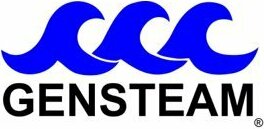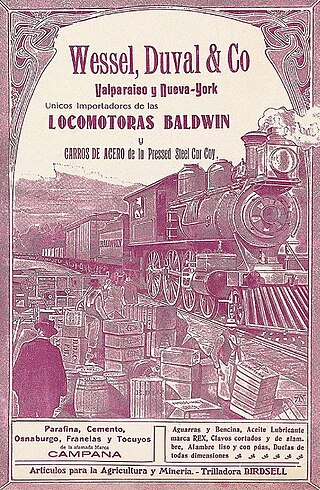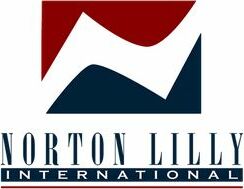Mississippi Shipping Company of New Orleans, Louisiana was a passenger and cargo steamship company founded in 1919. In 1961 officially changed its name to the Delta Line. The Mississippi Shipping Co. serviced port from the Gulf of Mexico and east coast of South America. The Mississippi Shipping Co. was formed to support coffee merchants and Brazilian produce to New Orleans and up the Mississippi River. competing with the New York City trade. Delta Line failed to upgrade to container ships and modernize as other shipping lines did in the 1970s. In 1982 Delta Line, now owned by the Holiday Inn Corporation sold the line to Crowley Maritime. Crowley was the largest US barge and tugboat operator at the time. Crowley started to modernize the ships on the route, but sold the shipping line to the United States Lines in 1985. United States Lines brought some of the ships into its routes but went bankrupt in 1986. At its peak in 1949, the Mississippi-Delta line owned 14 ships at a total of 98,000 grt. Delta Line also moved into passenger cruise with to ship. During World War II the Mississippi Shipping Company was active with charter shipping with the Maritime Commission and War Shipping Administration. During wartime, the Mississippi Shipping Company operated Victory ships, Liberty shipss, and a few Empire ships.
Pacific Far East Line, also called PFEL in short, was a passenger and cargo shipping line founded in 1943 by Thomas E. Cuffe, in San Francisco, California. At the beginning he started by chartering foreign ships to run the lines in tramp trade. Later scheduled cargo services were added to the line. During World War II the South Atlantic steamship line was active with charter shipping with the Maritime Commission and War Shipping Administration.
Barber Steamship Lines was founded in 1902 as Barber & Company Inc. and also operated the New York & Oriental Steamship Company. In 1928 Barber Steamship Lines operated the American West African Line. In 1945 Barber Steamship Lines was renamed the Wilhelmsen Lines, as it was acquired by Wilh. Wilhelmsen, a Norwegian company, later was renamed again to Barber International. American West African Line was closed in 1946, now part of Barber Steamship Lines. Barber Steamship Lines operated in the Far East and then around the World with Wilh. Wilhelmsen ships. Barber Steamship Lines also operated ships of British James Chambers & Company, Norwegian Fearnley & Eger Company and A. F. Klaveness & Co.

General Steamship Company was founded in 1920 in Houston, Texas, as a Private Company, and now goes by Gensteam since 1996. General Steamship Company has a fleet of cargo ships that operate worldwide. Gensteam has a Gensteam Operations Desk website that tracks all shipping logistics. Gensteam headquarters is now in San Francisco, California. General Steamship Company was part owner of American Pacific Steamship Company in New York state and Los Angeles during and post World War II. American Pacific Steamship Company was founded in 1942 in New York City, and was previously called Los Angeles Tanker Operators Inc. which operated T2 tanker ships. During World War II the General Steamship Company and American Pacific Steamship Company were active with charter shipping with the Maritime Commission and War Shipping Administration.

Agwilines Inc was a passenger and cargo shipping company of New York City. Agwilines is short for Atlantic, Gulf & West Indies Steamship Inc. AGWI Lines group operated four main lines in the 1910s, 1920s and 1930s:

Black Diamond Steamship Company (BDSC) operated passenger and cargo liners from New York City to Rotterdam and Antwerp. It was founded by J.E. Dockendorff in 1919, and named the American Diamond Line by the United States Shipping Board. The company was profitable in the 1920s and early 1930s. Prior to the United States' entry into World War II, the nation's neutrality policy ended much of the lines trade. Dockendorff stepped down as a principal executive in 1934, selling the only one of the company's 21 ships not owned by the government: the SS New Britain, which he had purchased in 1918. During World War II the company sold most of its American Diamond Line ships and moved to charter shipping with the Maritime Commission and War Shipping Administration. During the war, the Black Diamond Steamship Company operated Victory ships and Liberty ships. These ships were operated by their own crews; the US Navy supplied United States Navy Armed Guards to man the deck guns and radio. The most common armament mounted on these merchant ships were the MK II 20mm Oerlikon autocannon and the 3"/50, 4"/50, and 5"/38 deck guns. After the war there were many surplus ships and much competition. Black Diamond Steamship Company continued to operate after the war, but finally closed in 1955.
Shepard Steamship Company of Boston, Massachusetts was founded in 1930 by Otis N Shepard, and H B, Shepard with service from Pacific Coast to Philadelphia, New York City, Albany and Boston. Service was called the Shepard Line Shepard Steamship Company moved to 21 West Street, New York City in 1947. The Shepard Steamship Company's main cargo was lumber products. Otis N Shepard company, Otis Shepard & Co. partnered with George H. Morse in 1868 to form Shepard & Morse Lumber Company of Burlington, Vermont. During World War II the Shepard Steamship Company was active in charter shipping with the Maritime Commission and War Shipping Administration. During wartime, the Shepard Steamship Company operated Victory ships and Liberty shipss. The ship was run by its crew and the US Navy supplied United States Navy Armed Guards to man the deck guns and radio. The most common armament mounted on these merchant ships were the MK II 20mm Oerlikon autocannon and the 3"/50, 4"/50, and 5"/38 deck guns.

Interocean Shipping Company, Interocean Steamship Company of San Francisco was a subsidiary of the Bethlehem Steel Company founded in the late 1930s and closed in 1986.

Wessel, Duval & Co. was founded in Boston, Massachusetts in 1825 Augustus Hemenway (1805-1876) as Hemenway & Co.. Augustus Hemenway started the shipping company to move his timber products to markets. Augustus Hemenway had timberland in Maine and started his schooner shipping company to take timber to Eastcoast ports. Later he opened a sugar plant in Cuba, his ships would take lumber to Cuba and bring back sugar. Next, he expanded his timber products to Argentina and other Western South American ports. By 1828 the company expanded to Valparaiso, Chile. Augustus Hemenway married into a Boston merchant family, marrying Mary Tileston (1820-1894) in 1840. In 1865 Héctor Beéche (?-1914) became a partner in the firm and a subsidiary company, Wessel, Duval y Cía, was founded in Chile by Charles P. Hemenway, Augustus's brother. Charles had acted on Augustus' behalf in other matters as needed and became a partner in 1870. T. Quincy Browne became a partner in 1870 also and for a few years the firm was called Hemenway & Browne. In 1875 William Muller joined as a partner, the name returned to Hemenway & Co. Augustus Hemenway died in Cuba in 1876. The partnership continued as Hemenway & Co. till 1885. In 1885 Muller retired and Carlos Wolff joined the partnership, the company name was changed to Hemenway, Beeche and Co.. In 1888 Peter "Perdo" M. Wessel (1851-1821) joined the partnership and the company name was changed to Browne, Beeche and Co.. In 1891 a New York City office was opened on 68 Brad Street, and most key workers moved to New York. The next year the Boston office was closed. In 1896 Wolff retired and in 1897 George L. Duval (1855-1931), W. L. Parker, and q became partners. With the new partners, the company name was changed to Beeche and Co.. In 1905 T. F. Budge and Robert Jaffray became partners. In 1907 the company name was changed to Wessel, Duval & Co. In the 1900s the company moved from sailing ships to steamships and opened a new West Coast Line at 47 Cedar Street, later moved to 1 Broadway. The West Coast Line started regular service from New York City to Valparaiso and Callao, Peru. West Coast Line main cargo was railroad and mining equipment to the expanding business in Chile and Peru, along with general cargo. The Chile rail firm, Ferrocarril del Llano de Maipo in Santiago used Wessel, Duval & Co. to import their railroad equipment in 1890. The return cargo from Chile was nitrate of soda. The West Coast Line chartered steamship as needed and was the US manager and agent for other shipping lines. West Coast Line also shipped UK and US coal for coal ships and to nations. For the West coast of South America both the steamer and sail ships used the starits of Magellan, this changed on August 15, 1914, with the opening of the Panama Canal, some routes began to use the Panama Canal cutting about 10,000 miles off the trip. The outbreak of World War I changed service, some charted ships were requisition by their home country, and the United States Shipping Board, gave some ships to the Line to operate for the War effort. Normal operations did not return till 1924, all post-war work have been completed. In from 1920 to 1932, West Coast Line was the US agent for Compania Sud Americana de Vapores, the South America Steamship Company of Chile. South America Steamship Company had luxury passenger service to and from Chile and New York City, on a fleet of luxury steamers: SS Renaico, SS Aconcagua and SS Teno. During World War II Wessel Duval & Company operated ships to support the war in the Pacific War and European theatre. Wessel, Duval & Co. operated some ships in the support of Korean war in the early 1950s. As ships aged and were retired Wessel, Duval & Co. has moved into media, advertising and marketing.

Blidberg Rothchild Company was a shipping company founded by Allan Blidberg and Sylvester Rothschild in New York City, United States. The shipping company has is start with a previous company Blidberg and Sagen Company founded by Tryggve Sagen and Allan Blidberg. Tryggve Sagen owned a ship in Oslo, Norway before coming to the United States in 1919. Sylvester Rothschild was born in 1896 in Sweden, he was a finance officer in Gothenburg. Rothschild came to America in 1919 and started the shipping company with Sagen. Blidberg and Sagen Company had shipping routes from New York to Scandinavian and Baltic ports. Sagen was president, Blidberg vice president and Sylvester Rothschild was the Secretary for the shipping company. Sylvester Rothschild was from Gothenburg Sweden, where he was the Vice-consul. In the 1930s Tryggve Sagen departed the company and the firm was renamed Blidberg Rothchild Company. The company had offices in Gothenburg and Norway. Blidberg Rothchild Company worked with an affiliated company Eastport Steamship Co of New York. Blidberg Rothchild Company also worked with an affiliated company Bridgeport Steamship Line of New York, a New Haven Railroad company.

J. H. Winchester & Company was founded by James Henry Winchester (1824-1913) in New York City in 1856. J. H. Winchester & Company was a cargo agent for the United States Shipping Board post World War I, in the 1920s. Winchester raised and born in Annapolis, Nova Scotia, Canada, on June 4, 1824. He moved to the United States in 1831 and settled in Eastport, Maine. Winchester completed the United States naturalized prossess on July 7, 1845 and became a US citizen. He moved to New York and became a ship captain. In New York became a partner in two brigantine sailing ships, one the Mary Celeste. The Mary Celeste was found hastily abandoned in 1872 between the Azores and Portugal. The abandonment is still a mystery today.

Norton Lilly International, was founded as Norton Lilly & Company in 1841 in New York City by John Norton Jr., In 1834, John Norton, Jr. moved to New York in 1834, he was born in Eastport, Maine in 1816. John Norton, Jr. John Norton, Jr. shipping experience started in 1840 when he became a partner in Russell & Norton, a shipping agency for with routes from Florida to the West India. The ship operated out of Apalachicola, Florida and in 1851 added an Australia route to the line. In 1854 John Norton Jr., and his son, Edward N. Norton, opened his own shipping agency, Norton & Company and became the manager of the sailing ship Sea Flower , which operated out of Pensacola, Florida. Norton and son expanded and added a South America route with packet sailing ships. John Norton Jr. second son Augustus Norton joined the firm in 1878. Augustus Norton died on October 17, 1889, and a year later John Norton Jr. died on October 30, 1890. Edward N. Norton continued to run Russell & Norton, but in 1907, add a partner Joseph Thomas Lilly. With the new partnership, the firm was renamed Norton Lilly & Company.
Parry Navigation Company was a shipping company founded in 1942 by Alfred Walter Parry Jr. in New York City. Alfred Walter Parry Jr. first career was ship broker with Smith & Terry Inc. in New York City. He was also the office manager of the Interocean Steamship Company of New York in New Orleans. Smith & Terry Inc also were managing agents for the some United States Shipping Board ships. Alfred Walter Parry Jr. father, Alfred Walter Parry, Sr., was an agent for a railroad company. Parry Navigation Company operated ships for the World War II. Alfred Walter Parry Jr. became a Colonel in the United States Army. Parry served with the US Army Transportation Corps in the South Pacific Ocean. Parry Navigation Company expanded the company and opened an office in San Francisco in 1945. Parry Navigation Company stated the Parry Line in 1947 and expanded with route to Galveston, Texas. The Parry Line had routes from the West Coast of the United States to Manila, Shanghai, Hong Kong and North China. Parry was the vice president for the Lykes Brothers Steamship Company for a few years. Parry was awarded the Legion of Merit and World War II Victory Medal for his service in the US Army Transportation Corps. Charles W. Perkes was a manager in Parry Navigation Company. Perkes, before Parry worked for the Dollar Line.
Polarus Steamship Company was founded in 1918, and again in 1923 in New York City by Tikhon Nicholas Agapeyeff (1891–1931). Tikhon N. Agapeyeff's 1918 frim, operated for only about two years. In March 1921, Agapeyeff sold the first Polarus Steamship Company to the C. M. Fetterolf Company for $250,000. The next incorporation in 1923 was a partnership of Agapeyeff, Marcel Levy, and Charles S. Dunaif. Marcel Levy was an attorney and Charles S. Dunaif was an exporter.
Smith-Johnson Steamship Corporation, Smith & Johnson was founded by Howell B. Smith (1898-1979) and Algot W. Johnson (1900-1987) in 1921 in New York City. Howell B. Smith and Algot W. Johnson worked as ship brokers for the Munson Steamship Line before starting their own firm in 1921. Smith-Johnson Steamship Corporation's main work was as a shipbroker for Norwegian ships. During World War II Smith & Johnson operated ships to support the war effort, they also opened an office in New Orleans. Unlike other firms, they did not purchase any of the many surplus ships after the war. Smith and Johnson sold the firm in 1955, it continued to operate under other names till about 1982.
De La Rama Steamship Company, Inc. was a shipping company founded in New York City by the Isidro de la Rama family in 1930. Isidro de la Rama family founded the De La Rama Steamship Company to export sugar from their large his sugar plantations in the Philippines. Isidro de la Rama was also commissioned by the United States Army to be a blockade runner to bring supplies, such as food and ammunition, to the United States Army and Philippine Army after the invasion of Empire of Japan into the Philippines.
Prudential Steamship Corporation was a shipping company founded in 1933 in New York City by Stephan Stephanidis. Prudential Steamship Corporation operated the Prudential Lines. Prudential Lines main routes was from the United States to Mediterranean ports. The Prudential Lines was never successful and was always near bankruptcy. Prudential Lines was active in supporting the World War II efforts. At its peak in the 1960s Prudential Lines owned and operated two tankers, and five cargo ships. In 1960 the Prudential Steamship Corporation was sold to Spyros Skouras and his family. In 1969 the Prudential Lines merged with Grace Lines, which continued to operate the fleet as the Prudential Grace Line.
Sword Line Inc. was a steamship company founded by Charilaos "Charles" G. Poulacos and Abbott Abercrombie in New York City in 1933. Sword Line Inc. had shipping routes from Atlantic ports to and Gulf of Mexico ports. Charilaos "Charles" G. Poulacos and Abbott Abercrombie purchased the ship Eastern Sword in 1932. The Eastern Sword was a 3,785-ton cargo ship built in 1920 at the Uraga Dry Dock Co. Ltd, at Uraga, Japan. The ship sank after being hit by a torpedo from German submarine U-162 on May 4, 1942 twelve miles (19 km) off the coast of Georgetown, Guyana. The Eastern Sword had a crew of 38 and only 13 survived the attack. Sword Line Inc. was active in supporting the World War II effort.








